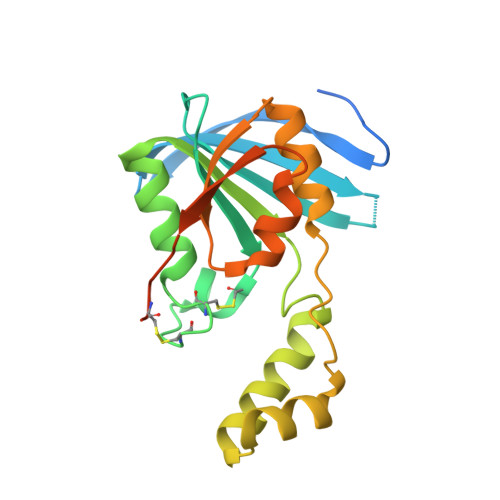Structural and biochemical characterization of GTP cyclohydrolase II from Helicobacter pylori reveals its redox dependent catalytic activity.
Yadav, S., Karthikeyan, S.(2015) J Struct Biol 192: 100-115
- PubMed: 26272484
- DOI: https://doi.org/10.1016/j.jsb.2015.08.004
- Primary Citation of Related Structures:
4RL4 - PubMed Abstract:
GTP cyclohydrolase II (GCHII), catalyzes the conversion of GTP to 2,5-diamino-6-β-ribosyl-4(3H)-pyrimidinone-5'-phosphate and has been shown to be essential for pathogens. Here we describe the biochemical, kinetic and structural characterization of GCHII from Helicobacter pylori (hGCHII). The crystal structure of hGCHII, unlike other GCHII structures, revealed that cysteines at the active site existed in oxidized state forming two disulfide bonds and lacked Zn(2+) that was shown to be indispensable for catalytic activity in other species. However, incubation of hGCHII with hydrogen peroxide, an oxidizing agent, followed by PAR-assay showed that Zn(2+) was intrinsically present, indicating that all cysteines at the catalytic site remained in reduced state. Moreover, site directed mutagenesis of catalytic site cysteines revealed that only three, out of four cysteines were essential for hGCHII activity. These results, though, indicated that hGCHII crystallized in oxidized form, the expulsion of Zn(2+) upon oxidation of catalytic cysteines revealed its ability to act in response to the redox environment. Exploring further, incubation of hGCHII with reversible thiol modifying agent S-methyl-methane-thiosulfonate resulted in loss of GCHII activity due to oxidation of its cysteine residues as revealed by mass spectrometry studies. However, addition of reducing agent DTT partially restored the hGCHII catalytic activity. Taken together, these results demonstrate that hGCHII can regulate its catalytic activity depending on the redox environment, a function hitherto unknown for GCHII.
Organizational Affiliation:
CSIR-Institute of Microbial Technology, Council of Scientific and Industrial Research (CSIR), Sector 39-A, Chandigarh 160 036, India.















